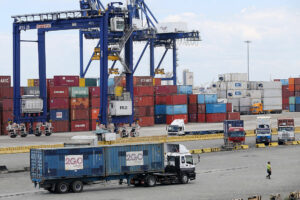THE GROWTH in Philippine exports seen in the first half could start slowing down beginning in early August after the 19% US reciprocal tariff took effect, an analyst said.
Rizal Commercial Banking Corp. (RCBC) Chief Economist Michael L. Ricafort said there was some frontloading of exports in recent months to avoid the US tariffs.
“But once the US tariffs become effective on Aug. 7, this could slow exports to the US by many countries,” he said via Viber.
Preliminary data from the Philippine Statistics Authority indicate that exports grew 13.2% in the first half to $41.24 billion.
Of the total, 16%, or $6.598 billion, was accounted for by the US. US shipments rose 13.2% from a year earlier.
In a recent trade forecast, the World Trade Organization (WTO) said that a surge of imports in the US ahead of widely anticipated tariff hikes contributed to the upward revision to the projections for 2025.
Starting Aug. 8, the WTO projects world merchandise trade to grow 0.9% in 2025, up from the -0.2% projected in April.
“Global trade has shown resilience in the face of persistent shocks, including recent tariff hikes. Frontloaded imports and improved macroeconomic conditions have provided a modest lift to the 2025 outlook,” WTO Director-General Ngozi Okonjo-Iweala said.
“However, the full impact of recent tariff measures is still unfolding. The shadow of tariff uncertainty continues to weigh heavily on business confidence, investment, and supply chains. Uncertainty remains one of the most disruptive forces in the global trading environment,” she added.
For next year, the WTO projects a 1.8% increase in world trade.
Despite the temporary boost of frontloading and more favorable global macroeconomic outlook on trade, the WTO still expects recent tariff changes to have an overall negative impact.
“This stems from a combination of factors. On the one hand, the US-China truce and exemptions for motor vehicles are contributing positively,” the WTO said.
“On the other hand, higher ‘reciprocal’ tariff rates introduced on Aug. 7 are expected to weigh increasingly on imports in the United States and depress exports of its trading partners in the second half of 2025 and in 2026,” it added.
Mr. Ricafort said Philippine exports are around three to five times smaller compared to those of other Association of Southeast Asian Nations (ASEAN) countries, insulating it from the tariff impact.
“The Philippine economy is not that export dependent and lately domestically driven, wherein about 70% of the economy was accounted for by consumer spending,” he said.
“The markets are still in a wait-and-see mode if Trump would be willing to compromise and settle for lower negotiated tariffs during the trade negotiations, given the TACO track record in recent months,” he added, referring to the “Trump Always Chickens Out” investment thesis being peddled by market traders.
The TACO thesis holds that Mr. Trump usually issues threats at the start of negotiations, then backs off later.
Despite this, Mr. Ricafort said the Philippines needs to diversify its export markets to other affluent markets.
“It is also better to diversify export winners beyond electronics, like agricultural export winners such as coconut oil, bananas, pineapples, mangoes, other tropical fruits, tuna, other seafood, or marine products,” he added.
Economic affairs officers Rajan Sudesh Ratna and Jing Huang of the UN Economic and Social Commission for Asia and the Pacific (ESCAP) are projecting that the US tariffs will reduce ASEAN exports to the US.
According to their report, “the higher tariffs will reduce China’s competitiveness and prompt global buyers to seek alternative suppliers, both reducing demand and redirecting trade flows.”
However, it said ASEAN countries will benefit from this shift, “gaining market share as trade is diverted away from China.”
“All ASEAN member countries gain purely through trade diversion rather than trade creation, indicating that while overall demand remains unchanged, supply sources are shifting,” it said.
“ASEAN’s ability to absorb trade diverted from China demonstrates the importance of flexible supply chains and open trade policies,” it added.
However, they said ASEAN must explore alternate markets beyond China, as their exports “may face challenges due to increased costs associated with tariffs, especially if their exports are levied duties for China.”
To address these challenges, they recommended that bloc members increase intra-ASEAN trade.
“Strengthening intra-regional trade through harmonization of regulations and reduction of tariffs among member states will create a more robust internal market within ASEAN itself and prevent them from absorbing the external shock emanating from the additional US tariffs,” they said.
They said ASEAN should adopt a collective approach to enhancing bargaining power in negotiations with external partners to reduce reliance on the US market.
They added that “ASEAN can capitalize on the shifting trade dynamics by promoting bilateral and regional economic partnerships with China.”
Another recommendation is for ASEAN to look into market diversification, focusing on countries with which it has free trade agreements (FTAs), and to actively pursue new FTAs.
They also recommended a focus on services trade and the adoption of digital policies.
“With the US reciprocal tariffs imposed across the board on almost all countries with higher duties on China, some of the supply chain linkages of ASEAN members are likely to be disrupted,” they said.
“ASEAN must formulate an alternate export strategy. In this regard, looking at other important markets, focusing on services trade by including it in its FTAs, entering into FTAs with other major trading partners, and discussing how to enhance intra-ASEAN trade are some of the options,” they added. — Justine Irish D. Tabile

